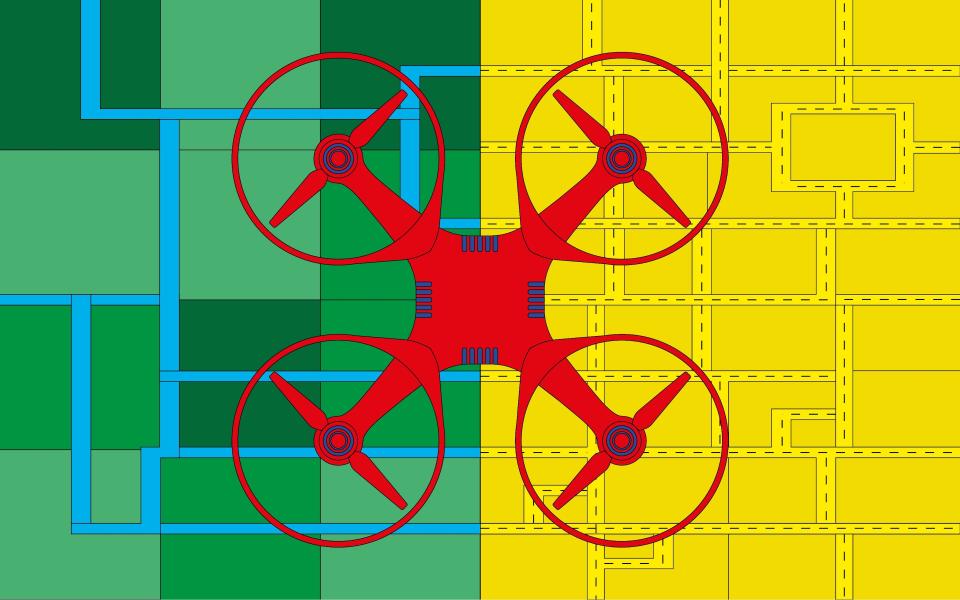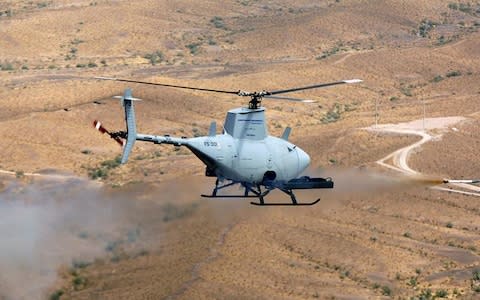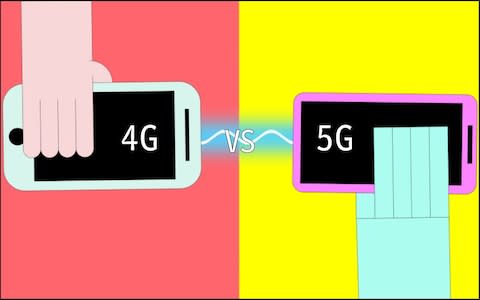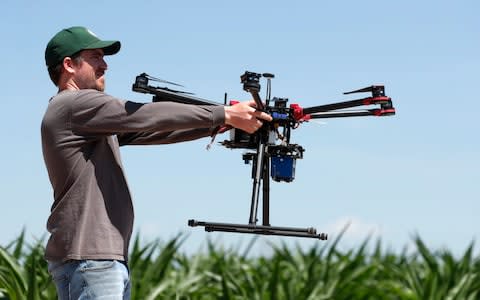How the $127bn drone industry will change the way we live

The drones that slammed into the Saudi Arabian oil processing plants at Abqaiq and Khurais early on Saturday sent shockwaves around the world by knocking out 5pc of the world's oil supply.
But the use of unmanned vehicles to wage war or stir up trouble is just one of the more dramatic ways in which drones are changing the way we live
The global drone industry is now worth $127bn and reaches into virtually every field of human endeavour: from war to healthcare and entertainment.
Border patrols and security
Europe's borders may soon be patrolled by swarms of drones fitted with advanced sensors to patrol the air, land and sea.
The European Union has backed the £7.7m ‘Roborder’ project which will focus on hotspots for illegal immigration throughout Europe, providing constant surveillance of unauthorised border crossings, smuggling routes or possible pollution spills.
Currently there is no plan for these drones to be armed. They will simply be used to inform border officers at control centres – but a more dystopian future could easily take shape.
“In some parts of the world drones equipped with pepper spray and plastic ball ammunition are being used for strike busting and breaking up protests,” said Noel Sharkey, a member of the Campaign to Stop Killer Robots.
“Surveillance robots require fast response from border forces to intercept intruders and if border pressure increases as we see with the Syrian conflict, they may well be armed."

Philip Binks, head of Air Traffic Management at UK drone company Altitude Angel, said the use of drones in border patrols poses legal questions.
He said: "It gets quite complicated when you fly across international boundaries. If you have the approval to operate in one country, do you have the right to operate it in a different one?" Airspace regulation that governs aircrafts will need to be adapted for drones, he argues.
Private local security companies are also drones for surveillance. Companies such as the American Nightingale Security have developed a system using sensors and UAVs to patrol private property, recognising intruders or potential health risks and live-streaming video back to a control room.
Internet
Imagine far up in the sky beyond the clouds, a swarm of solar-powered drones tracing figures of eight that can beam information down to the ground at a moment's notice and never need recharging.
This is the vision of BAE engineers, who plan to develop devices that are capable of staying in the sky for a year providing 5G mobile networks to remote areas or disaster zones.
Last week, the company bought Hampshire-based start-up Prismatic to build a small, remote-controlled solar plane weighing just 150kg.
Airbus holds the record for endurance, flying big six-winged drones for 25 days without landing at over 75,000 feet, an altitude that just a few aircraft like the Concord have reached.

However, this competitive space has already triggered the demise of similar projects from Facebook, which aimed to create internet-beaming drones after buying UK start-up Ascenta but was forced to shut its operations last year after regulatory scrutiny and an unfortunate crash.
If these projects take off, they could provide a lot more than just internet connectivity – they could replace the costly space-bound satellite equipment used in global communications and help us to reduce the amount of space junk floating in our thermosphere.
Instead of leaving unusable satellites floating in space, companies and the public sector could recall a drone and upgrade it, says Dr Owen McAree of Liverpool John Moors University.
"The cost of launching this is much cheaper than a satellite and you can upgrade it much more easily."
Insurance
US insurance companies have led the charge for commercial drone use, taking out licences to use the technology as early as 2015 for projects that range from charting rooftops to inspecting damaged crops.
Insurers can use drones to check the extent of damage in locations where there has been a claim, and can help to counter fraud claims which cost them £1.3bn in the UK alone.
According to the Association of British Insurers, half a million insurance frauds were detected in 2017 – or one every minute – from lying when applying for cover to making a dishonest claim.
Drones will form a part of the third industrial revolution for insurers, alongside big data and blockchain, says Nick Humphrey, partner at law firm Kennedys.

"There is a real focus from insurers on fraud and insurance claim, and there is a view that big data and blockchain is going to remove or reduce the costs of things for today.
"The human eye is not as accurate as some of the technology attached to these drones.
"If you are looking at industrial claims, which are high value claims, which might require some close inspections of cracks and damage, it's more cost-effective and safer than someone getting up on scaffolding and it's quicker."
"One of the elements of this type of use is that it doesn't face many regulatory issues. The people using it are certified, they are not using it for an unlimited time. It shouldn't infringe on people's privacy.
Regulation in future will be important, Humphrey says.
"A lot of it will be the regulatory environment: the licencing and use and training and integration of those elements into ensuring that those insurers are doing that in a safe manner. Insurers don't want new claims against them from people over drones."
Retail
Amazon is pressing ahead with its Prime Air future-delivery concept, which the retail giant plans to deliver small packages autonomously. The drones will fly from Amazon’s fulfilment centres to the customer “within 30 minutes” the company claims.
Prime Air may be the most high-profile example of companies looking to use autonomous vehicles to deliver goods, but there are plenty of others.
Boeing-backed Matternet is developing its own drone-delivery platform while Google parent company Alphabet is also exploring the area.

It isn’t just goods either. Uber has announced it is gearing up to test food delivery via drone on its Uber Eats service, with restaurants loading pizzas and burgers onto drones before they are whisked to the customer autonomously.
The benefit is speed; a drone delivery could take only five to 10 minutes in a local area as opposed to nearly half an hour by vehicle.
These projects face delays and potential regulatory hurdles, but could eventually be an area where autonomous vehicle technology makes a big impact.
Healthcare
As well as dropping off fast food to hungry customers, drones are also set to be used in healthcare too.
UAVs have been used in humanitarian crisis response for several years, flown in to assess areas and transport critical medical supplies.
In future, drones could be used more widely to respond to emergencies in local areas. Companies such as UK start-up GoodSAM are exploring ways drones could be used to help save lives, including sending in portable defibrillators to those in need.
A trained operator in the drone’s control room can also use cameras to assess situations and instructing bystanders in ways they can help.

"Fire and police services are using them now," says Binks. "The fire service can get a bird's-eye view of the incident and can identify risks and hazards quickly, and they don't have to expose firefighters to unnecessary risks. Healthcare has huge potential.
"We know from the NHS they are trying to centralise a lot of pathology activities and sending samples from hospitals –blood delivery by drone. You are not at risk of delaying a hospital receiving blood because of traffic, and you are not putting the public at risk as well."
Transport
It may sound like a science-fiction pipe dream but the advent of flying taxis may be closer than you expect.
From Uber to Bristol start-up Vertical Aerospace, big money is being invested in small autonomous aircraft for private transport. Germany's Volocopter recently raised another £45m from investors.
The first wave set to appear in the next few years will be piloted, but the majority of companies are looking at using advanced drone technology.

Defence
Unmanned weapons of war have been in development since World War I and the Hewitt-Sperry Automatic Airplane, and several experiments in World War II were performed with remote-controlled bombing runs.
But while the concept may not be new to the battlefield, the growing sophistication of drones coupled with their falling cost and the ease with which the technology can be acquired has changed warfare.
The military drone market alone is set to be worth $13bn by 2024, driven by government defence spending.
The US alone forked out $4.5bn on its drone programme in 2017, with American companies such as Lockheed Martin, Northrop Grumman and Boeing making up 60pc of the military market. India and Korea are investing billions of dollars too.
The UK is exploring the possibilities of swarms of smaller drones, as well as the forthcoming, laser-armed RAF Protector. It isn’t just UAVs either, with autonomous boats set to patrol the seas such as BAE Systems P950 Rib.
But whilst the military powers of the world are always looking for any advantage, using drones for tasks such as reconnaissance to targeted strikes, incidents like the Saudi attack show that it is the accessibility of unmanned vehicles that is changing the face of 'asymmetric' warfare.
Agriculture and conservation
Drones could play a role in cutting unnecessary food waste and help farmers use existing farming space better.
Around a fifth of all businesses in the sector are now using drone technology to monitor livestock or to distribute fertiliser across their land, and sales of such drones are expected to exceed 1bn globally by 2024.
Drones could not only help farmers to increase their bottom line, they could also give them eyes in the sky to watch over their crops, improving their yield by performing inspections to identify any issues such as over-watering or crop damage, spraying crops and even planting them.

This same principle is being used for the preservation of endangered animals and their habitats, with drones flying over the area without disturbing them and allowing scientists to count them.
Whether it’s a field or a rainforest canopy, drones are able to document spaces that would take days if not weeks of arduous work by hand.
Organisations like WWF have used thermal drones to deter poachers from sneaking into protected areas to kill endangered species, allowing them to cover much more space than in vehicles and examine any suspicious activity.
Beyond visual line of sight capability will be a key part of the use of this technology, as conservationists and farmers look to cover more space
